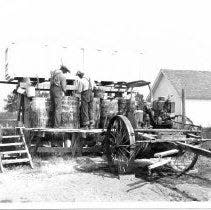Step Back in Time: When the potato ruled in Elmira
This month’s Step Back in Time comes to us from the 1975 Commemorative Centennial Edition, celebrating the first 100 years of Otsego County. The 40-page publication was assembled by the staff at the then Otsego County Herald Times, known today as the Gaylord Herald Times. The article provides a snapshot in time of the community celebrating the county’s centennial back in 1975.
Elmira, located in a valley surrounded by hills, first saw life over 100 years ago. As with the other areas, lumbering was the main attraction. The village was first called Windsor. A gap in records does not indicate when the name was changed to Elmira.
The Grand Rapids & Indiana Railroad came through Elmira in 1873, bringing an influx of lumbermen who proceeded to clear the land and settle the village. The many trains that passed through refueled at the coal dock and filled their tanks with water from the Pump House Pond. A roundhouse was set up to repair the railroad cars and locomotives. Sidings were established at key points so cars could be loaded and unloaded. A spur ran south into Mt. Jack along the county line where freight cars could be lined up for over a mile.
The village grew rapidly and by 1892 a flourishing community was in operation. Businesses were constructed; including two hotels which housed the many transients, a post office was established, a church, school and town hall were built. Four sawmills gave employment to the local residents.

The mills were owned by Jerry Mahoney, Sam Schuyler, Albert Losey and M. Phiffer. They made barrel staves, cheese boxes and sawed lumber for construction. Frank Gregg acted as postmaster while A. Brooks took charge of the school. Four saloons were in operation at this time. A population of 400 supported this thriving community.
The early 1900s brought about a decline in lumbering as the virgin forests were depleted. Another source of income was required. The fertile land in the area proved to be excellent for the growing of potatoes. By 1920 most of the region was producing potatoes, creating a need for warehouses. Men such as Thomas Buell, Frank Zaremba, Stanley Kwapis and Frank J. Polus, erected buildings with scales to weigh the potato wagons coming and going. Large storage bins housed the potatoes until they could be bagged and shipped to different parts of the state and beyond.
Certified seed potatoes were in great demand in the 1920s. Dr. Ernest Nixon (an uncle of President Nixon) found the area around Elmira to be perfect for this purpose. Nixon encouraged the people to expand in this line and as a result, Thomas Buell became the largest grower of certified seed potatoes in the state.
Fires destroyed most of the businesses in Elmira. The owners did not rebuild but moved on to other endeavors. In 1975 the village consisted of a store, one tavern, a Catholic church and a farm equipment dealership. Frank Zaremba owned and operated a grocery store and saloon inside the dealership. When fire destroyed this structure, he constructed a building to handle the farm equipment. His sons, Walter and Chester, have continued the business and today they are the third largest International Harvester farm equipment dealers in Michigan.
Literary talent has been recognized among Elmira’s citizens. Esca Rodger, sister of the well known Dr. John R. Rodger, wrote a book about the area titled, “Year of Bitterness.” A Catholic priest, who spent his childhood in Elmira, has written several books pertaining to the Catholic religion. Thomas B. Buell, a Naval Commander and grandson of the late Thomas Buell, has written a biography about a World War II Naval Admiral. He received the Alfred Thayer Mahan Award for Literary Achievement.
The population is currently around 150 residents but is again on the upswing. New businesses are locating in the vicinity, bringing in new families. Potato growing is still a major source of income for some families. Growing large quantities of potatoes in Elmira are Walter Burdo, Arthur Estelle, the Makarewicz family, Joseph Ciszewski and Louis Francis. The times indicate steady growth for the community.
This article originally appeared on The Petoskey News-Review: Step Back in Time: When the potato ruled in Elmira
